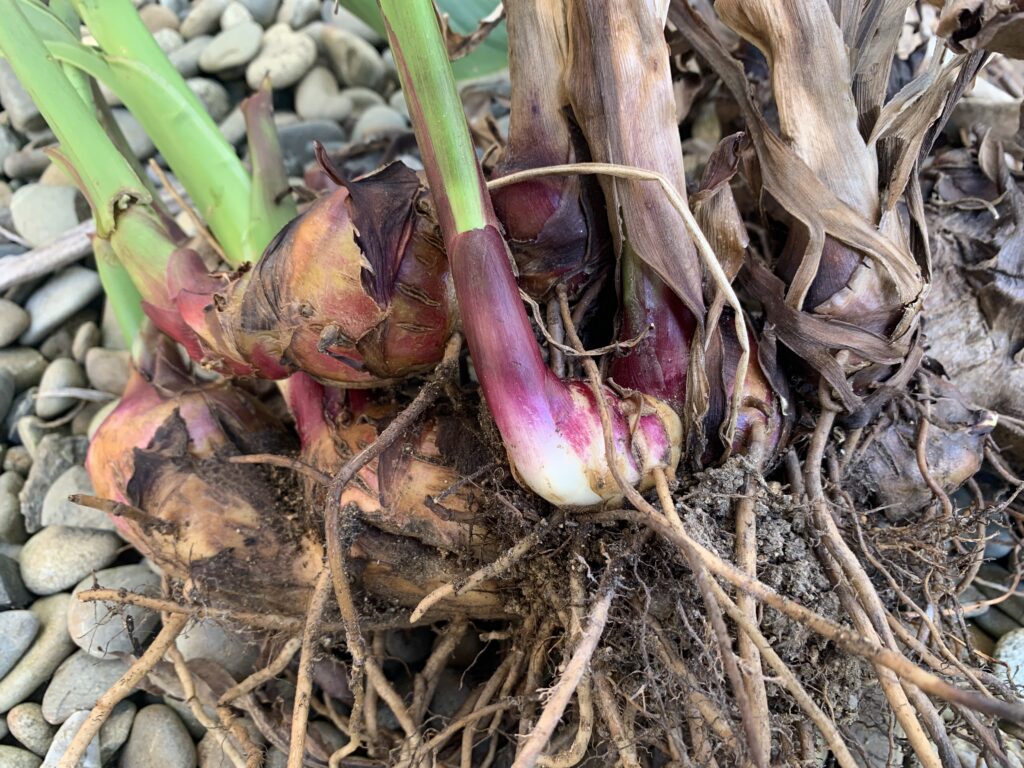Botanical name : Canna indica
Synonyms : Canna edulis, Canna discolor
Common name : Queensland Arrowroot, Achira, Indian shot, African arrowroot, edible canna, purple arrowroot, Sierra Leone arrowroot
Easy by division, Intermediate difficulty for seed saving
Lifecycle: Perennial
Pollination: Insect pollinated
Mating system: Hermaphrodite flowers
Suggested spacing: Same as for eating production
Seed specific requirements: Unknown. Likely sub-tropical or warmer climate.
Isolation distance: Unknown
Population size: Unknown
Seed maturity: Seed is harvested when the capsule containing them dries and goes brown.
Processing method: Dry threshing
Expected seed viability: Unknown
Images

Growing for seed or division
Queensland arrowroot is usually propagated by division. In southern Australia it may not flower at all so division is the only option for propagation. Even in zones where it does flower it does not produce much seed.
Selection
As Queensland arrowroot is generally a poor seed producer selection will be based on plants that produce seed the most prolifically.
Harvest
Harvesting for seed: When the capsule turns brown and dries. Fruit is globular and rough skinned. As the seed matures the fruit dries and becomes a capsule containing the seeds.
Harvesting for division: The rhizomes can be dug at almost any time of the year. In cooler regions it is most convenient to dig them up during winter when the plants have died back. Cut back all leaves when digging up. Rhizomes can be cut into pieces for replanting. In humid, wet climates it can be helpful to leave the rhizomes in a shady but airy location to heal cuts before replanting into new locations.
Processing
Seeds are black and very hard. They are easily removed from the seed heads when they are mature and dried.
Cultivation
Seed may need scarifying to initiate germination. Pour very hot water over the seeds and allow to cool.
In temperate climates with frost the plants will die back over winter and then reshoot in the spring.
Uses
The rhizomes and fleshy buds can be processed to produce arrowroot flour. This is easily done in the home kitchen as the starch granules are large and fairly easy to separate from the fibres of the rhizomes and terminal buds.
The basic method for extracting the starch is to cut off the fibrous roots and scrub the rhizomes well. They can be grated, with the skin on, using a food processor. The resulting shreds are placed in a container with copious amounts of water. Vigorous stirring will create a milky solution. Pour the mixture though a colander or fine sieve to remove all the plant material leaving only the water. Remove as much plant material as possible at this point while retaining the milky water. Allow the solution to sit for a short while. The starch will settle to the bottom leaving clear water above. The water can be carefully decanted off. The wet starch can be poured into a cloth lined colander to be collected. From there it is spread out as evenly as possible on fine cloths such as a tea towel or sheet and left to dry. Ensure it dries promptly, by either leaving it in a warm, airy location or by turning a fan on to it. Once completely dry it can be gathered into a jar for storage and used the same way as commercial arrowroot flour.
Other Resources
Contributors
Liz Worth, Nellie Pryke
